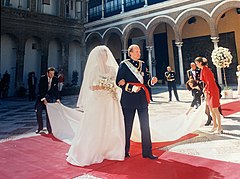Wedding of Infanta Elena and Jaime de Marichalar
 Infanta Elena departs the Royal Alcázar of Seville of the arm of her father for her wedding to Jaime de Marichalar | |
| Date | 18 March 1995 |
|---|---|
| Venue | |
| Location | Seville, Andalusia, Spain |
| Participants | |
The wedding of Infanta Elena of Spain and Don Jaime de Marichalar y Sáenz de Tejada, Lord of Tejada, took place on Saturday, 18 March 1995 at Seville Cathedral in Seville, Andalusia.
Infanta Elena is the eldest child of King Juan Carlos I and Queen Sofía of Spain, at the time of her marriage, she was second in line to the Spanish throne. Marichalar, a Spanish nobleman, is the third son of Amalio de Marichalar y Bruguera, 8th Count of Ripalda (1912–1979), and María de la Concepción Sáenz de Tejada y Fernández de Boadilla, Countess of Ripalda, Lady of Tejada (1929–2014).
This wedding was the first royal wedding celebrated in Spain in 89 years.[1]
Engagement[edit]
Infanta Elena, the elder daughter of King Juan Carlos I and Queen Sofía of Spain, met Spanish nobleman Jaime de Marichalar, in Paris in 1987.[2] Elena was studying French literature and Marichalar was working for Credit Suisse.[2] Their relationship remained private until 1993 when the press first photographed them and rumours of an engagement began. Their engagement was announced on 23 November 1994.[3] Their engagement was celebrated at the Palace of Zarzuela on 26 November with members of the Spanish royal family in attendance.[4]
Marichalar presented the Infanta with a diamond engagement ring created with diamonds from a tiara belonging to his mother. In turn, Infanta Elena presented her fiancé with a watch[4]
Pre-wedding celebrations[edit]
On 17 March, the couple with their families attended a performance by the Royal Andalusian School of Equestrian Art at the Plaza de toros de la Real Maestranza de Caballería de Sevilla.[5]
That evening, a dinner for family members and foreign royal guests was held at the home of the bride's great-aunt and great-uncle, Princess María de la Esperanza and Prince Pedro Gastão of Orléans-Braganza, in Villamanrique de la Condesa.[5]
Royal dukedom[edit]
On 3 March 1995, King Juan Carlos created his daughter Duchess of Lugo, a substantive title. The Royal Decree stated:[6]
In attention to the circumstances that occur in My very dear daughter Her Royal Highness Doña Elena de Borbón, Infanta of Spain, on the occasion of her marriage and as proof of My deep affection and love, I have seen fit to grant her, for life, the power to use the title of Duchess of Lugo.
This is what I provide by this Royal Decree.— JUAN CARLOS R., Royal Decree n.º 323 of 3 March 1995.
Upon marriage, Marichalar became duke consort and remained so until the couple divorced in 2010.
Wedding[edit]

Wedding service[edit]
The doors of Seville Cathedral opened early in the morning for guests to arrive. Political representatives, Spanish high society and friends of the couple were the first to arrive. Felipe González, Prime Minister of Spain, was the last to arrive before the groom and members of foreign royal families. Don Jaime and his mother arrived together, departing from the Hotel Alfonso XIII.
At 12:15 local time, a procession consisting of the members of the Spanish royal family departed the Royal Alcázar of Seville for the cathedral. The bride on the arm of her father followed at 12:30 local time. As the bride and her father arrived at the cathedral, the Marcha Real, Spain's national anthem, was played on the organ.[7]
The readings were an extract from the First Epistle to the Corinthians, Psalm 119, and Gospel of John: 9-12. The Archbishop gave the homily before the marriage rite took place.[citation needed]
Broadcast[edit]
Televisión Española (TVE) produced the live institutional television signal, directed by Pilar Miró, that was distributed to all major networks in Spain. TVE itself broke its all-time record for morning audience, with more than 8.6 million viewers, and 71.4% share in average. Counting the national networks –without counting the regional ones–, the wedding attracted more than 10.5 million viewers.[8]
References[edit]
- ^ Tremlett, Giles (19 March 1995). "Spain's Princess Elena married". UPI. Retrieved 8 October 2020.
- ^ a b "El economista que entró en Zarzuela | elmundo.es". www.elmundo.es. Retrieved 16 October 2023.
- ^ Galaz, Mábel (24 November 1994). "La infanta Elena se casa con Jaime de Marichalar". El País (in Spanish). ISSN 1134-6582. Retrieved 16 October 2023.
- ^ a b Galaz, Mábel (27 November 1994). ""Jaime no paró hasta convencerme"". El País (in Spanish). ISSN 1134-6582. Retrieved 16 October 2023.
- ^ a b "La Casa del Rey anuncia que la boda de la infanta Elena será a las 12.30". El País. 15 January 1995. Retrieved 8 October 2020.
- ^ Royal Household (4 March 1995), Real Decreto 323/1995, de 3 de marzo, por el que se concede, con carácter vitalicio, la facultad de usar el titulo de Duquesa de Lugo a Su Alteza Real la Infanta Doña Elena (in Spanish), p. 7477, retrieved 15 October 2023
- ^ "Periódico ABC MADRID 19-03-1995, portada". abc.es. 13 March 1995. Retrieved 1 December 2016.
- ^ Álvarez, Paz (21 March 1995). "Más de diez millones de españoles siguieron la boda real". El País (in Spanish).
